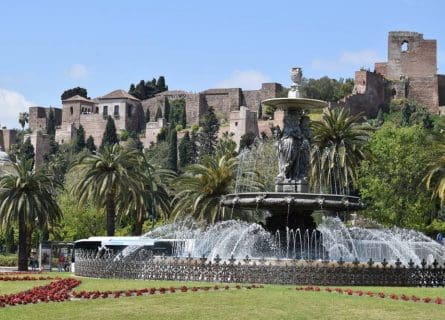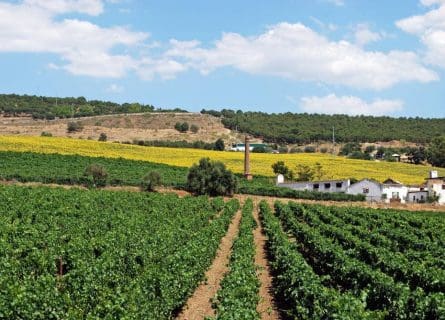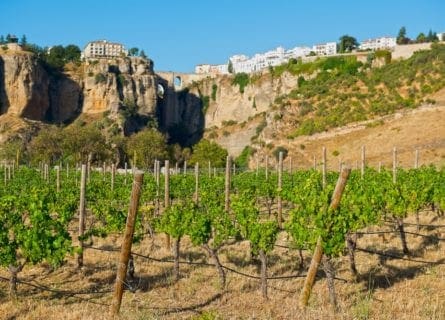Immerse yourself in Córdoba's vibrant flavors and uncover hidden culinary gems with our expert insider guides. Plan an unforgettable trip today!
Read more
EXPLORE ALL OUR ANDALUCIA WINE REGIONS GUIDE
Last updated: August 15, 2024
Southern Spain invokes all sorts of expectations from first-time visitors: endless sunshine, whitewashed villages, flamenco, and bite-sized morsels served with Sherry on tap. Fortunately, you don’t have to look hard to find all the above. Yet tourist cliches are only part of the region’s charm. In the hills that flank the cities of Málaga and Ronda, a quiet revolution is reshaping Andalucia’s viticultural map; dry styles now rival the best wines of Rioja and Ribera del Duero, including a growing volume of aromatic whites and structured, elegant reds. In addition, Andalucia is also home to the lesser-known fortified wines of the Málaga D.O. (appellation), based on the inimitably delicious Moscatel grape. As it turns out, Sherry is not Andalucia’s only contribution to the world of wine. Surprises, shocks, and innovation await.
Discover more about Spanish Wine

Andalucía is undoubtedly the most enchanting, mysterious, and dramatically beautiful of Spain’s great wine regions. Historians believe the Phoenicians introduced the first vines, an ancient maritime civilization that traded across Europe from their base in modern-day Lebanon. However, the first documented evidence of wine production dates back to the Roman period; Rome conquered the Iberian Peninsula in the 3rd century B.C., following the defeat of the Carthaginians during the Punic Wars. Their vast Western Empire endured for over six centuries, including territories in England, North Africa, and France. And, as Rome’s cultural influence spread, so too did viticulture and the social conventions associated with wine drinking. By the early 5th century, most of Western Europe was planted to vines.
However, as the empire became ever-more decadent and corrupt, disaster beckoned. The Visigothic general Alaric sacked Rome in 410; the Western Empire fell apart in 476. This created an unprecedented power vacuum in Spain that several competing civilizations were eager to fill. In the early 6th century, the Visigoths were pushed out of Gaul (France) by the Franks, eventually establishing a power base in Toledo.
Yet by the eighth century, the Visigothic kingdom was on the point of collapse, not least due to widespread famine and constant infighting. This paved the way for the Muslim invasion of 711, which set Spain’s destiny apart from the rest of Europe. It was spearheaded by the Muslim governor of Tangier, Tariq ibn Ziyad, who led a force of Arab and Berber mercenaries into Andalucia in 711. The Moors took over most of the Iberian Peninsula within a few years, bringing scientific and cultural advancements. They built palaces, mosques, gardens, and universities in the main cities. Meanwhile, their improved irrigation techniques saw agriculture flourish in Andalucia with the growing of oranges, sugar cane, lemons, peaches, and rice.
But the Muslim antipathy towards alcohol was legendary. Initially, being drunk was punishable by death, although more lenient measures – fines and taxes – were introduced in the latter stages of their reign.
Nevertheless, a Christian revolt gained real momentum in the Middle Ages, culminating in a siege of the last Muslim Stronghold, Granada, in the 15th century. The Catholic Monarchs Isabel and Fernando defeated the last ruler of a Muslim Caliphate, Boabdil, in 1492. One of their first tasks was to reinvigorate Andalucia’s winegrowing industry, establishing a Fraternity of Vintners (Hermandad de Viñeros) to manage the production of local wines. This once again became a lucrative and thriving enterprise, while gold and silver from the New World colonies enriched the monarchy beyond its wildest dreams.
Unfortunately, much of this newfound wealth was squandered on endless wars with rival European powers. Yet exports of Málaga sweet wines flourished in the 1700s; at the end of the 18th century, the wines of Málaga were better known than those of Jerez de la Frontera. Sadly, production dropped considerably after the Phylloxera louse destroyed most of Europe’s vineyards at the end of the 19th century, combined with the Spanish Civil War’s turmoil, ensured that the industry contracted considerably by the 1950s. Consumers’ waning interest in sweet wines and the overriding preference for aromatic, dry whites was the final nail in the coffin. There seemingly was little room for the once-revered sweet nectar of Málaga.
Yet in the past 10-15 years, a renaissance has occurred in this almost forgotten Andalusian wine region. Pioneers like Telmo Rodriguez have helped revive the moribund Moscatel industry with his stunning Molino Real wines, which have found favor across Europe and encouraged a new generation of wine drinkers to enjoy Málaga’s sweet wines. There has also been a surge of interest in red wine production, particularly around the gorgeous city of Ronda, where the German Friedrich Schatz planted his first vines in 1982. Andalucia, after a difficult period, is back at full vinous strength.

The vineyards of Málaga are planted in a vast geographical area in southern Andalucia, encompassing some 1000 hectares of vines. Indeed, winegrowing occurs in the mountainous hinterland north of Málaga and along the city’s Mediterranean coastline. Antequera, Axarquia, San Pedro Alcantara, Manilva, Ronda, and Velez are the main production areas. Such a wide production area inevitably offers great differences in terroir and climatic zones, leading to diverse growing conditions. The westernmost subregion, Manilva, is close to the Atlantic and benefits from its cooling influences. The humid weather and rich, fertile soils produce large, bountiful harvests, most of which are used in table grape production.
Meanwhile, the region of Axarquia lies at the opposite end of the province, east of Málaga. Many vineyards are at high altitudes, planted on steep terraces over gravelly limestone soils, necessitating manual grape harvesting. After harvesting, the crop is usually dried on open-air beds in the hot Andalusian sun to raisin the grapes and concentrate the sugars. The predominant grape variety here is Moscatel, or Muscat de Alexandria, grown worldwide under various synonyms. The grape has powerful floral and earthy flavors and thrives in hot climates like Andalusia.
The Antequera subzone, which is to be found north of Málaga, is predominately planted with the Pedro Ximenez grape, although many of Málaga’s wines are made from a blend of the two varietals. The soils are predominately iron and clay-based, with a significant amount of limestone.
Most of Málaga’s wine is produced in this inland sub-region, characterized by savage climate extremes – boiling summers and cold winters. This does seem to suit its signature variety – Ximenez. It was allegedly named after a 17th-century soldier who is thought to have brought the variety from the Rhine via the Canary Islands. Unfortunately, no such evidence exists, but it remains a good story! Pedro Ximenez is a soft, thin-skinned white variety that needs a hot climate to ripen fully. The resulting wine has a very high sugar content, made even higher after the raising process employed by the region’s growers. This process accounts for the wine’s traditionally dark color, although both Moscatel and Pedro Ximenez are white grapes.
If you head northwest from Málaga City, you’ll soon arrive at the spectacular living museum called Ronda. Before the arrival of Friedrich Schatz in the region, the area had languished in obscurity, with few vineyards and no real status as a wine region. Today the surrounding landscape supports a thriving – and growing – wine industry; the vineyards are some of the highest in the Málaga zone, rising to over 750 meters above sea level. The terroir is a mixture of alluvial and calcareous soils, while the climate is quintessential Mediterranean: hot summers and mild winters. As elsewhere, elevation is the winegrowers’ secret weapon. This encourages diurnal temperature variation (a significant temperature difference between day and night), which maintains acidity in the grapes. Without this topographical advantage, producing fresh and balanced wines in southern Andalucia would be challenging.

There are two key appellations in the Málaga province: Málaga and Sierras de Málaga D.O. The former was created in 1932 and continues to regulate the production of sweet wines in the region; Sierras de Málaga was introduced in 2001 as a specific appellation for dry white, red, and rosé wines. Under the Málaga D.O. rules, fortified and passito (sun-dried) styles can be produced, although the appellation is exclusively devoted to sweet wines.
Winemaking has not changed much over the centuries, albeit growers have harnessed all the benefits of modern viticultural techniques and winemaking equipment. After harvesting and raising, the berries are usually fermented on-site in the growers’ often small and basic wineries. This rich base wine will then be taken to ancient cellars in Málaga, where it is mixed with a spirit or sweet, thickened must (arrope). Like Sherry, it is matured using the Solera process whereby older vintages are blended with young ones and aged gradually.
Over time, the Málaga sweet dessert wine matures in wooden barrels and gains color, texture, flavor, and aroma. The D.O. guidelines stipulate that it must be aged for at least two years though some are aged for much longer. Old wines can display an incredible assortment of flavors and aromas: caramel, coffee, raisins, cocoa, nuts, spice, plums, and violets have all been found. A wonderful accompaniment to rich desserts, our first choice would be to match with a rich chocolate dessert. Some older dry examples do exist, comparable to the Oloroso sherry in flavor.
However, in addition to the classic Málaga wine styles described above, a movement has been growing championing lighter, dryer wines, which are unfortified and released at a younger age. These wines have become trendy with sommeliers across the Spanish restaurant trade. They are an encouraging example of the Málaga wine growers adapting to the current climate of tastes and preferences rather than stubbornly refusing to modify their output. The best dry wines of Sierras de Málaga are no less excellent, particularly the Cabernet Sauvignon/Petit Verdot blends that offer an intriguing mix of exotic black fruit and a spicy finish. Today there is also a great deal of buzz surrounding the vineyards of Ronda, where exciting developments have been happening in winemaking since the early 1980s.
That year, an entrepreneur called Friedrich Schatz, who had already researched the region’s potential, visited the area in 1982 and soon realized that the diurnal variation in temperature, with warm days and cooler nights, presented ideal growing conditions for certain grape varieties. He founded Bodegas Friedrich Schatz and planted Petit Verdot, Cabernet Sauvignon, Pinot Noir, Chardonnay, Tempranillo, Lemberger, and Muskattrollinger – a relative of the Muscat family. His success in crafting high-quality wines encouraged others to invest in the area, and today winemakers from Spain, Argentina, and even Austria market their wares.
After years of lobbying, winemakers in Ronda were granted an official sub-appellation D.O.: Serranía de Ronda. Of course, the wines vary in style and quality, but the best show a powerful ripeness and intensity of fruit, balanced by good acidity. The wines are a testament to how far the Málaga industry has come in a little over 30 years. It has been rescued from a slow death by pioneers like Telmo Rodriguez and Schatz, who revitalized the fantastic potential of this historic winemaking region and have invested countless hours into bringing its reputation back into the fold. On the evidence to date, they’ve succeeded.
Over the past 15 years, a renaissance has occurred in this once-forgotten corner of Andalusia. Pioneers like Telmo Rodriguez have helped to revive the moribund Moscatel industry with his stunning Molino Real wines, which have found favor across Europe and encouraged a new generation of wine drinkers to enjoy Málaga’s sweeter styles. There has also been a surge of interest in red wine production, particularly around the gorgeous city of Ronda and the higher-altitude sites in the Southern Andalucia mountains. The resurgence in Málaga’s late-harvest dessert wines is a development we can all applaud. But, commercial reality will ultimately dictate Andalucia’s future, which lies in producing high-quality dry styles: wines that balance ripeness against finesse.
Initially, that seemed like a quixotic fantasy – how can fresh dry whites be made in a hot Mediterranean climate? Is this the best environment for Pinot Noir and Sauvignon Blanc? In light of climate change, controlling ripeness and alcohol levels in many Spanish regions has become a major headache. Yet due to the wider region’s undulating landscape, this goal can be achieved.
The first ingredient is elevation: vineyards planted in Andalucia climb to 1,300 meters above sea level. Rivaling the most spectacular mountain vineyards of the Mendoza region in Argentina, temperatures plummet in the evening in these high-altitude sites. So the vine’s metabolism grinds to a snail’s pace. Winegrowers use this natural device worldwide to avoid a high pH and unwieldy alcohol; acid is not lost as the berries accumulate sugars. Intelligent canopy management, clonal selection, and earlier harvests are also important. In a world where international markets are increasingly king, deviation from this paradigm is not advised.
Of course, purists may claim that classical values are being lost with the increasing commonality of dry wines, but there are enough styles and variety to please everyone today. That includes investors and accountants, who continue to encourage – or maybe coerce – winemakers into producing commercially viable wines that can be sold abroad. But, thanks to men like Rodriguez, the Moscatel and Pedro Ximenez grapes also play a role in 21st-century Andalucia.
Chardonnay is a green-skinned grape varietal native to the Burgundy wine region in France and one of the most popular varieties worldwide.
Find out moreThe Moscatel grape, renowned for its aromatic allure and luscious sweetness, also plays a significant role in the world of Sherry. This versatile grape variety contributes to the creation of exceptional Sherries, adding depth, complexity, and a touch of honeyed richness to these fortified wines.
Indulge in the Sweetness of Pedro Ximénez: A Resplendent Grape for Andalusia's Montilla-Moriles. Experience the Richness of Sweet Sherries & Fortified Wines.
Find out moreThe sauvignon blanc grape varietal, originally from the Bordeaux region of France, is now one of the world's most loved white varieties.
Find out moreDiscover Viura: Rioja's Prominent White Grape & Catalonia's Macabeo. Explore its versatility in exquisite wines. A must-read for wine enthusiasts.
Find out moreDiscover the irresistible allure of Cabernet Sauvignon—a worldwide favorite with robust, dark-bodied flavor. Unleash your wine journey today!
Find out moreGarnacha: Spain's Red Gem. Akin to Pinot Noir, it bridges terroir and winemaking, crafting captivating expressions.
Find out moreMerlot is the most cultivated grape in Bordeaux and closely related to Cabernet Franc
Find out morePetit Verdot is a full-bodied red wine grape varietal used in classic Bordeaux blends and originates in southwestern France
Find out moreSyrah is dark-skinned and perhaps the most underrated of the 'noble' red grape varieties.
Find out moreExplore the allure of Tempranillo Blanco: La Rioja, Spain's unique white grape. Born from a red Tempranillo mutation, it unveils a refreshing twist in every sip.
Find out moreAndalucian cooking is quintessentially Mediterranean: olive oil, garlic, onions, tomatoes, and peppers are used liberally in many traditional dishes. Meanwhile, the fruit and vegetables grown in Andalucia are delicious and fresh; the growing season is almost year-round. But, most visitors regard tapas as the seminal gastronomic experience while touring Spain. These bar snacks have become a cuisine in their own right, and each Spanish region has its specialties. There’s infinite scope for talented chefs to combine flavors and textures, especially in the atmospheric taverns of Málaga’s old town. Culinary heaven awaits.
Guide to Andalusian Gastronomy: Read more

Immerse yourself in Córdoba's vibrant flavors and uncover hidden culinary gems with our expert insider guides. Plan an unforgettable trip today!
Read more
Immerse yourself in Granada's vibrant flavors and uncover hidden culinary gems with our expert insider guides. Plan an unforgettable trip today!
Read more
Immerse yourself in Ronda's vibrant flavors and uncover hidden culinary gems with our expert insider guides. Plan an unforgettable trip today!
Read more
Immerse yourself in Seville's vibrant flavors and uncover hidden culinary gems with our expert insider guides. Plan an unforgettable trip today!
Read moreIf you would like us to customize an exclusive luxury tour, contact us and let us know your travel plans. We offer luxury food and wine tours for private groups of a mininium two guests. In addition, all of our private, chauffeured tours are available year-round upon request.

